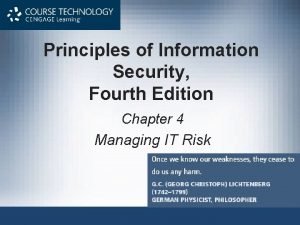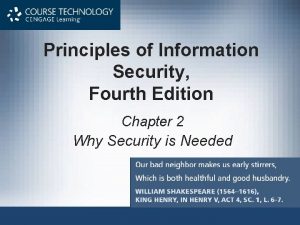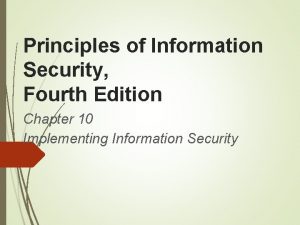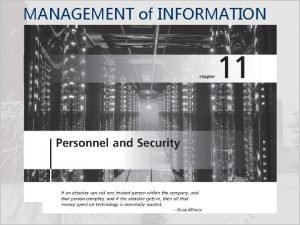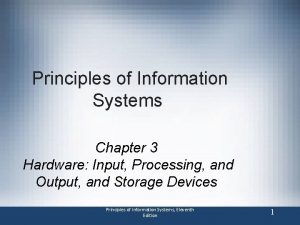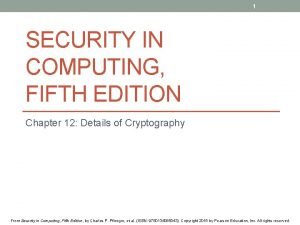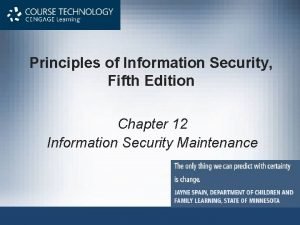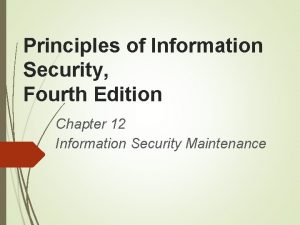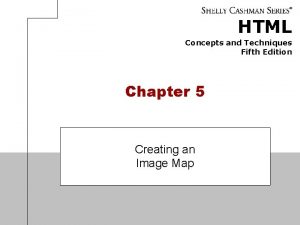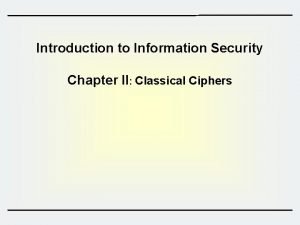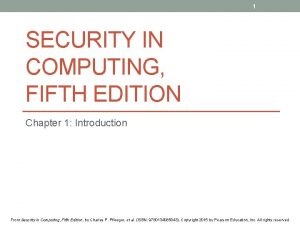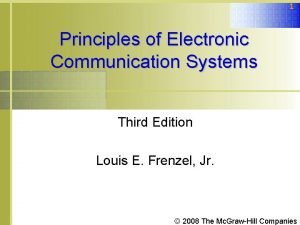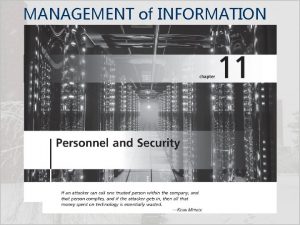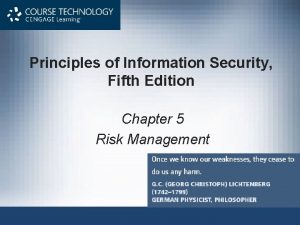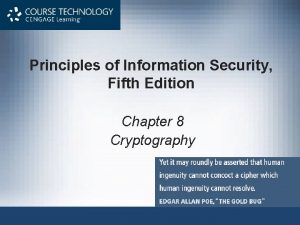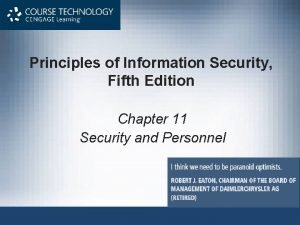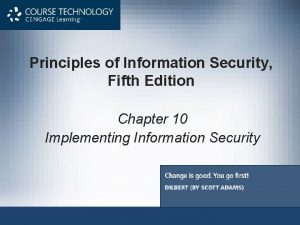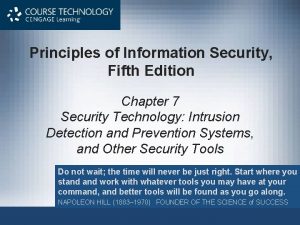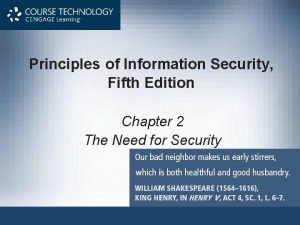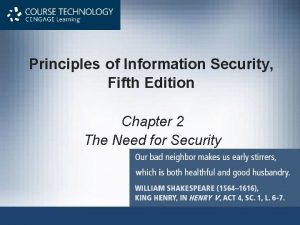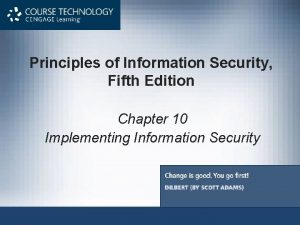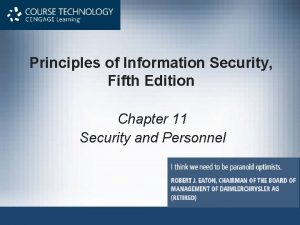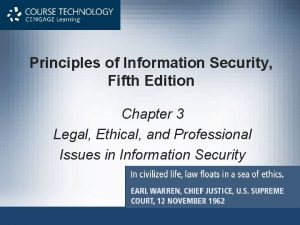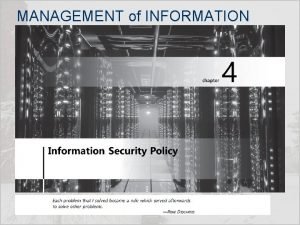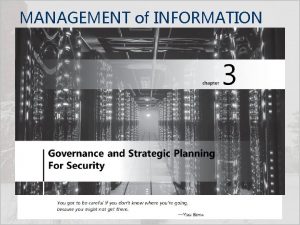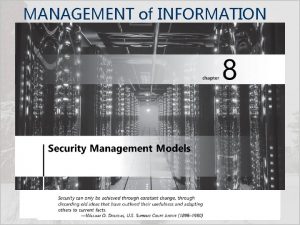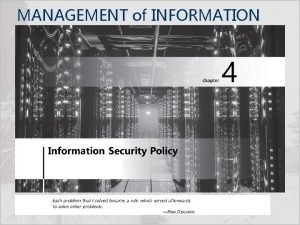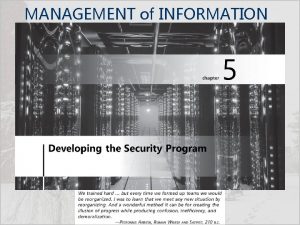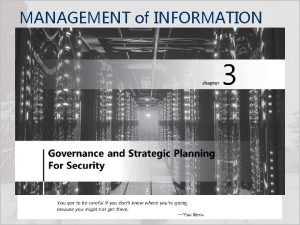Principles of Information Security Fifth Edition Chapter 2
























































- Slides: 56

Principles of Information Security, Fifth Edition Chapter 2 The Need for Security

Learning Objectives • Upon completion of this material, you should be able to: – Discuss the organizational business need for information security – Explain why a successful information security program is the shared responsibility of an organization’s general management and IT management – List and describe threats posed to information security and common attacks associated with those threats – Describe the relationship between threats and attacks against information within systems Principles of Information Security, Fifth Edition 2

Introduction • The primary mission of an information security program is to ensure information assets— information and the systems that house them— remain safe and useful. • If no threats existed, resources could be used exclusively to improve systems that contain, use, and transmit information. • Threat of attacks on information systems is a constant concern. Principles of Information Security, Fifth Edition 3

Business Needs First • Information security performs four important functions for an organization: – Protecting the organization’s ability to function – Protecting the data and information the organization collects and uses – Enabling the safe operation of applications running on the organization’s IT systems – Safeguarding the organization’s technology assets Principles of Information Security, Fifth Edition 4

Protecting the Functionality of an Organization • Management (general and IT) is responsible for facilitating security program. • Implementing information security has more to do with management than technology. • Communities of interest should address information security in terms of business impact and cost of business interruption. Principles of Information Security, Fifth Edition 5

Protecting Data That Organizations Collect and Use • Without data, an organization loses its record of transactions and ability to deliver value to customers. • Protecting data in transmission, in processing, and at rest (storage) is a critical aspect of information security. Principles of Information Security, Fifth Edition 6

Enabling the Safe Operation of Applications • Organization needs environments that safeguard applications using IT systems. • Management must continue to oversee infrastructure once in place—not relegate to IT department. Principles of Information Security, Fifth Edition 7

Safeguarding Technology Assets in Organizations • Organizations must employ secure infrastructure hardware appropriate to the size and scope of the enterprise. • Additional security services may be needed as the organization grows. • More robust solutions should replace security programs the organization has outgrown. Principles of Information Security, Fifth Edition 8

Threats • Threat: a potential risk to an asset’s loss of value • Management must be informed about the various threats to an organization’s people, applications, data, and information systems. • Overall security is improving, so is the number of potential hackers. • The 2010– 2011 CSI/FBI survey found – 67. 1 percent of organizations had malware infections. – 11 percent indicated system penetration by an outsider. Principles of Information Security, Fifth Edition 9

Principles of Information Security, Fifth Edition 10

Principles of Information Security, Fifth Edition 11

Principles of Information Security, Fifth Edition 12

Compromises to Intellectual Property • Intellectual property (IP): creation, ownership, and control of original ideas as well as the representation of those ideas • The most common IP breaches involve software piracy. • Two watchdog organizations investigate software abuse: – Software & Information Industry Association (SIIA) – Business Software Alliance (BSA) • Enforcement of copyright law has been attempted with technical security mechanisms. Principles of Information Security, Fifth Edition 13

Deviations in Quality of Service • Information system depends on the successful operation of many interdependent support systems. • Internet service, communications, and power irregularities dramatically affect the availability of information and systems. Principles of Information Security, Fifth Edition 14

Deviations in Quality of Service (cont’d) • Internet service issues – Internet service provider (ISP) failures can considerably undermine the availability of information. – Outsourced Web hosting provider assumes responsibility for all Internet services as well as for the hardware and Web site operating system software. • Communications and other service provider issues – Other utility services affect organizations: telephone, water, wastewater, trash pickup. – Loss of these services can affect organization’s ability to function. Principles of Information Security, Fifth Edition 15

Principles of Information Security, Fifth Edition 16

Deviations in Quality of Service (cont’d) • Power irregularities – Commonplace – Lead to fluctuations such as power excesses, power shortages, and power losses – Sensitive electronic equipment vulnerable to and easily damaged/destroyed by fluctuations – Controls can be applied to manage power quality. Principles of Information Security, Fifth Edition 17

Espionage or Trespass • Access of protected information by unauthorized individuals • Competitive intelligence (legal) versus industrial espionage (illegal) • Shoulder surfing can occur anywhere a person accesses confidential information. • Controls let trespassers know they are encroaching on organization’s cyberspace. • Hackers use skill, guile, or fraud to bypass controls protecting others’ information. Principles of Information Security, Fifth Edition 18

Principles of Information Security, Fifth Edition 19

Espionage or Trespass (cont’d) • Expert hacker – Develops software scripts and program exploits – Usually a master of many skills – Will often create attack software and share with others • Unskilled hacker – Many more unskilled hackers than expert hackers – Use expertly written software to exploit a system – Do not usually fully understand the systems they hack Principles of Information Security, Fifth Edition 20

Principles of Information Security, Fifth Edition 21

Espionage or Trespass (cont’d) • Other terms for system rule breakers: – Cracker: “cracks” or removes software protection designed to prevent unauthorized duplication – Phreaker: hacks the public telephone system to make free calls or disrupt services • Password attacks – – – Cracking Brute force Dictionary Rainbow tables Social engineering Principles of Information Security, Fifth Edition 22

Principles of Information Security, Fifth Edition 23

Forces of Nature • Forces of nature can present some of the most dangerous threats. • They disrupt not only individual lives, but also storage, transmission, and use of information. • Organizations must implement controls to limit damage and prepare contingency plans for continued operations. Principles of Information Security, Fifth Edition 24

Human Error or Failure • Includes acts performed without malicious intent or in ignorance • Causes include: – Inexperience – Improper training – Incorrect assumptions • Employees are among the greatest threats to an organization’s data. Principles of Information Security, Fifth Edition 25

Principles of Information Security, Fifth Edition 26

Human Error or Failure (cont’d) • Employee mistakes can easily lead to: – – – Revelation of classified data Entry of erroneous data Accidental data deletion or modification Data storage in unprotected areas Failure to protect information • Many of these threats can be prevented with training, ongoing awareness activities, and controls. • Social engineering uses social skills to convince people to reveal access credentials or other valuable information to an attacker. Principles of Information Security, Fifth Edition 27

Social Engineering • “People are the weakest link. You can have the best technology; firewalls, intrusion-detection systems, biometric devices. . . and somebody can call an unsuspecting employee. That's all she wrote, baby. They got everything. ”—Kevin Mitnick • Advance-fee fraud: indicates recipient is due money and small advance fee/personal banking information required to facilitate transfer • Phishing: attempt to gain personal/confidential information; apparent legitimate communication hides embedded code that redirects user to third-party site Principles of Information Security, Fifth Edition 28

Principles of Information Security, Fifth Edition 29

Information Extortion • Attacker steals information from a computer system and demands compensation for its return or nondisclosure. Also known as cyberextortion. • Commonly done in credit card number theft Principles of Information Security, Fifth Edition 30

Sabotage or Vandalism • Threats can range from petty vandalism to organized sabotage. • Web site defacing can erode consumer confidence, diminishing organization’s sales, net worth, and reputation. • Threat of hacktivist or cyberactivist operations is rising. • Cyberterrorism/Cyberwarfare: a much more sinister form of hacking Principles of Information Security, Fifth Edition 31

Principles of Information Security, Fifth Edition 32

Software Attacks • Malicious software (malware) is used to overwhelm the processing capabilities of online systems or to gain access to protected systems via hidden means. • Software attacks occur when an individual or a group designs and deploys software to attack a system. Principles of Information Security, Fifth Edition 33

Software Attacks (cont’d) • Types of attacks include: – Malware (malicious code): It includes the execution of viruses, worms, Trojan horses, and active Web scripts with the intent to destroy or steal information. • Virus: It consists of code segments that attach to existing program and take control of access to the targeted computer. • Worms: They replicate themselves until they completely fill available resources such as memory and hard drive space. • Trojan horses: malware disguised as helpful, interesting, or necessary pieces of software Principles of Information Security, Fifth Edition 34

New Table Principles of Information Security, Fifth Edition 35

Principles of Information Security, Fifth Edition 36

Software Attacks (cont’d) • Types of attacks (cont’d) • Polymorphic threat: actually evolves to elude detection • Virus and worm hoaxes: nonexistent malware that employees waste time spreading awareness about – Back door: gaining access to system or network using known or previously unknown/newly discovered access mechanism Principles of Information Security, Fifth Edition 37

Software Attacks (cont’d) • Types of attacks (cont’d) – Denial-of-service (Do. S): An attacker sends a large number of connection or information requests to a target. • The target system becomes overloaded and cannot respond to legitimate requests for service. • It may result in system crash or inability to perform ordinary functions. – Distributed denial-of-service (DDo. S): A coordinated stream of requests is launched against a target from many locations simultaneously. Principles of Information Security, Fifth Edition 38

Principles of Information Security, Fifth Edition 39

Software Attacks (cont’d) • Types of attacks (cont’d) – Mail bombing (also a Do. S): An attacker routes large quantities of e-mail to target to overwhelm the receiver. – Spam (unsolicited commercial e-mail): It is considered more a nuisance than an attack, though is emerging as a vector for some attacks. – Packet sniffer: It monitors data traveling over network; it can be used both for legitimate management purposes and for stealing information from a network. – Spoofing: A technique used to gain unauthorized access; intruder assumes a trusted IP address. Principles of Information Security, Fifth Edition 40

Principles of Information Security, Fifth Edition 41

Software Attacks (cont’d) • Types of attacks (cont’d) – Pharming: It attacks a browser’s address bar to redirect users to an illegitimate site for the purpose of obtaining private information. – Man-in-the-middle: An attacker monitors the network packets, modifies them, and inserts them back into the network. Principles of Information Security, Fifth Edition 42

Principles of Information Security, Fifth Edition 43

Technical Hardware Failures or Errors • They occur when a manufacturer distributes equipment containing a known or unknown flaw. • They can cause the system to perform outside of expected parameters, resulting in unreliable service or lack of availability. • Some errors are terminal and some are intermittent. • Intel Pentium CPU failure • Mean time between failure measures the amount of time between hardware failures. Principles of Information Security, Fifth Edition 44

Technical Software Failures or Errors (cont’d) • Large quantities of computer code are written, debugged, published, and sold before all bugs are detected and resolved. • Combinations of certain software and hardware can reveal new software bugs. • Entire Web sites are dedicated to documenting bugs. • Open Web Application Security Project (OWASP) is dedicated to helping organizations create/operate trustworthy software and publishes a list of top security risks. Principles of Information Security, Fifth Edition 45

The Deadly Sins in Software Security • Common failures in software development: – – – – Buffer overruns Command injection Cross-site scripting (XSS) Failure to handle errors Failure to protect network traffic Failure to store and protect data securely Failure to use cryptographically strong random numbers Principles of Information Security, Fifth Edition 46

The Deadly Sins in Software Security (cont’d) • Common failures in software development (cont’d): – – – – Format string problems Neglecting change control Improper file access Improper use of SSL Information leakage Integer bugs (overflows/underflows) Race conditions SQL injection Principles of Information Security, Fifth Edition 47

The Deadly Sins in Software Security (cont’d) • Problem areas in software development: – – – Trusting network address resolution Unauthenticated key exchange Use of magic URLs and hidden forms Use of weak password-based systems Poor usability Principles of Information Security, Fifth Edition 48

Technological Obsolescence • Antiquated/outdated infrastructure can lead to unreliable, untrustworthy systems. • Proper managerial planning should prevent technology obsolescence. • IT plays a large role. Principles of Information Security, Fifth Edition 49

Theft • Illegal taking of another’s physical, electronic, or intellectual property • Physical theft is controlled relatively easily. • Electronic theft is a more complex problem; the evidence of crime is not readily apparent. Principles of Information Security, Fifth Edition 50

Secure Software Development • Many information security issues discussed here are caused by software elements of the system. • Development of software and systems is often accomplished using methodology such as systems development life cycle (SDLC). • Many organizations recognize the need for security objectives in SDLC and have included procedures to create more secure software. • This software development approach is known as Software Assurance (SA). Principles of Information Security, Fifth Edition 51

Software Assurance and the SA Common Body of Knowledge • A national effort is underway to create a common body of knowledge focused on secure software development. • U. S. Department of Defense and Department of Homeland Security supported the Software Assurance Initiative, which resulted in the publication of Secure Software Assurance (Sw. A) Common Body of Knowledge (CBK). • Sw. A CBK serves as a strongly recommended guide to developing more secure applications. Principles of Information Security, Fifth Edition 52

Software Design Principles • Good software development results in secure products that meet all design specifications. • Some commonplace security principles: – – – Keep design simple and small Access decisions by permission not exclusion Every access to every object checked for authority Design depends on possession of keys/passwords Protection mechanisms require two keys to unlock Programs/users utilize only necessary privileges Principles of Information Security, Fifth Edition 53

Software Design Principles (cont’d) • Some commonplace security principles: – Minimize mechanisms common to multiple users – Human interface must be easy to use so users routinely/automatically use protection mechanisms. Principles of Information Security, Fifth Edition 54

Summary • Unlike any other aspect of IT, information security’s primary mission is to ensure things stay the way they are. • Information security performs four important functions: – Protects organization’s ability to function – Enables safe operation of applications implemented on organization’s IT systems – Protects data the organization collects and uses – Safeguards the technology assets in use at the organization Principles of Information Security, Fifth Edition 55

Summary (cont’d) • Threat: object, person, or other entity representing a constant danger to an asset • Management effectively protects information through policy, education, training, and technology controls. • Attack: a deliberate act that exploits vulnerability • Secure systems require secure software. Principles of Information Security, Fifth Edition 56
 Principles of marketing fifth european edition
Principles of marketing fifth european edition Failure of supporting utilities and structural collapse
Failure of supporting utilities and structural collapse Principles of information system
Principles of information system Ranked vulnerability risk worksheet
Ranked vulnerability risk worksheet Principles of information security 4th edition
Principles of information security 4th edition Bulls eye model in information security
Bulls eye model in information security Psychology ciccarelli 5th edition chapter 1
Psychology ciccarelli 5th edition chapter 1 Fundamentals of corporate finance fifth edition
Fundamentals of corporate finance fifth edition Fifth edition chemistry a molecular approach
Fifth edition chemistry a molecular approach Molecular biology of the cell
Molecular biology of the cell Molecular biology of the cell fifth edition
Molecular biology of the cell fifth edition Human anatomy fifth edition
Human anatomy fifth edition Human anatomy fifth edition
Human anatomy fifth edition Computer security principles and practice
Computer security principles and practice Computer security principles and practice 4th edition
Computer security principles and practice 4th edition Management of information security 5th edition
Management of information security 5th edition Privatesecurity
Privatesecurity Principles of information systems 11th edition
Principles of information systems 11th edition Visa international security model
Visa international security model Nstissc security model
Nstissc security model Security in computing pfleeger ppt
Security in computing pfleeger ppt Nist sp 800-55
Nist sp 800-55 12 principles of information security
12 principles of information security Using mis 10th edition
Using mis 10th edition Chapter 1
Chapter 1 Senge fifth discipline summary
Senge fifth discipline summary Fifth chapter menu
Fifth chapter menu Chapter 9 information management and security
Chapter 9 information management and security Introduction to information security chapter 2
Introduction to information security chapter 2 Network security essentials 5th edition
Network security essentials 5th edition Modulo table
Modulo table Cryptography and network security 6th edition pdf
Cryptography and network security 6th edition pdf Cryptography and network security 4th edition
Cryptography and network security 4th edition Security in computing 5th edition answers
Security in computing 5th edition answers Computer security fundamentals 4th edition
Computer security fundamentals 4th edition Network security essentials 5th edition
Network security essentials 5th edition Cryptography and network security pearson
Cryptography and network security pearson Principles of electronic communication systems 3rd edition
Principles of electronic communication systems 3rd edition Principles of economics oxford fajar
Principles of economics oxford fajar Accounting principles second canadian edition
Accounting principles second canadian edition Accounting principles second canadian edition
Accounting principles second canadian edition Accounting principles second canadian edition
Accounting principles second canadian edition Stephen robbins principles of management
Stephen robbins principles of management Involuntary inactive real estate license florida
Involuntary inactive real estate license florida Beginning inventory formula
Beginning inventory formula Accounting principles second canadian edition
Accounting principles second canadian edition Principles of marketing arab world edition
Principles of marketing arab world edition Florida real estate principles practices & law 43rd edition
Florida real estate principles practices & law 43rd edition The circuit chapter 8 summary
The circuit chapter 8 summary Accounting principles 13th edition
Accounting principles 13th edition Principles of electronic communication systems 3rd edition
Principles of electronic communication systems 3rd edition Principles of marketing chapter 2
Principles of marketing chapter 2 Principles of economics mankiw 9th edition ppt
Principles of economics mankiw 9th edition ppt Rational people think at the margin
Rational people think at the margin Expert systems: principles and programming, fourth edition
Expert systems: principles and programming, fourth edition Principles of economics mankiw 9th edition ppt
Principles of economics mankiw 9th edition ppt Introduction to information systems 6th edition
Introduction to information systems 6th edition



